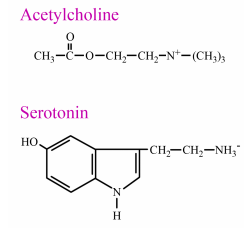8.2: Receptores de canal iónico activados por ligando
- Page ID
- 53836

Este tipo de respuesta rápida se observa, por ejemplo, en las uniones neuromusculares, donde las células musculares responden a un mensaje de la célula nerviosa vecina. La célula nerviosa libera una señal de neurotransmisor en la hendidura sináptica, que es el espacio entre la célula nerviosa y la célula muscular con la que está “hablando”. Ejemplos de moléculas señal de neurotransmisores son acetilcolina y serotonina, que se muestran en la Figura 8.2.2.

Cuando las moléculas de acetilcolina se liberan en la hendidura sináptica (el espacio entre las células pre y possinápticas) se difunden rápidamente hasta llegar a sus receptores en la membrana de la célula muscular. La unión de la acetilcolina a su receptor, un canal iónico en la membrana de la célula muscular, hace que la puerta en el canal iónico se abra. El flujo de iones resultante a través del canal puede cambiar inmediatamente el potencial de la membrana. Esto, a su vez, puede desencadenar otros cambios en la celda. La velocidad con la que se producen cambios en la señalización de neurotransmisores es evidente cuando piensas en la rapidez con la que retiras tu mano de una superficie caliente. Las neuronas sensoriales llevan información al cerebro desde tu mano sobre la superficie caliente y las neuronas motoras señalan a tus músculos para mover la mano, ¡en menos tiempo del que te llevó leer esta frase!



